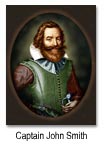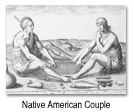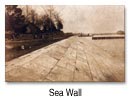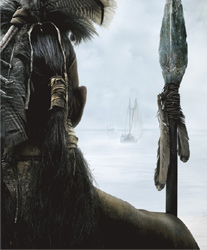
In June of 1606, King James I granted a charter to a group of London entrepreneurs, the Virginia Company, to establish a satellite English settlement in the Chesapeake region of North America. By December, 108 settlers sailed from London instructed to settle Virginia, find gold and a water route to the Orient. Some traditional scholars of early Jamestown history believe that those pioneers could not have been more ill-suited for the task. Because Captain John Smith identified about half of the group as "gentlemen", it was logical, indeed, for historians to assume that these gentry knew nothing of or thought it beneath their station to tame a wilderness. Recent historical and archaeological research at the site of Jamestown suggest that at least some of the gentlemen and certainly many of the artisans, craftsmen, and laborers that accompanied them all made every effort to make the colony succeed.
 On May 14, 1607, the Virginia Company explorers landed on Jamestown Island, to establish the Virginia English colony on the banks of the James River 60 miles from the mouth of the Chesapeake Bay. By one account, they landed there because the deep water channel let their ships ride close to shore; close enough, to moor them to the trees. Recent discovery of the exact location of the first settlement and its fort indicates that the actual settlement site was in a more secure place, away from the channel, where Spanish ships, could not fire point blank into the Fort. Almost immediately after landing, the colonists were under attack from what amounted to the on-again off-again enemy, the Algonquian natives. As a result, in a little over a months' time, the newcomers managed to "beare and plant palisadoes" enough to build a wooden fort. Three contemporary accounts and a sketch of the fort agree that its wooden palisaded walls formed a triangle around a storehouse, church, and a number of houses. While disease, famine and continuing attacks of neighboring Algonquians took a tremendous toll on the population, there were times when the Powhatan Indian trade revived the colony with food for copper and iron implements. It appears that eventual structured leadership of Captain John Smith kept the colony from dissolving. The "starving time" winter followed Smith's departure in 1609 during which only 60 of the original 214 settlers at Jamestown survived. That June, the survivors decided to bury cannon and armor and abandon the town. It was only the arrival of the new governor, Lord De La Ware, and his supply ships that brought the colonists back to the fort and the colony back on its feet. Although the suffering did not totally end at Jamestown for decades, some years of peace and prosperity followed the wedding of Pocahontas, the favored daughter of the Algonquian chief Powhatan, to tobacco entrepreneur John Rolfe. On May 14, 1607, the Virginia Company explorers landed on Jamestown Island, to establish the Virginia English colony on the banks of the James River 60 miles from the mouth of the Chesapeake Bay. By one account, they landed there because the deep water channel let their ships ride close to shore; close enough, to moor them to the trees. Recent discovery of the exact location of the first settlement and its fort indicates that the actual settlement site was in a more secure place, away from the channel, where Spanish ships, could not fire point blank into the Fort. Almost immediately after landing, the colonists were under attack from what amounted to the on-again off-again enemy, the Algonquian natives. As a result, in a little over a months' time, the newcomers managed to "beare and plant palisadoes" enough to build a wooden fort. Three contemporary accounts and a sketch of the fort agree that its wooden palisaded walls formed a triangle around a storehouse, church, and a number of houses. While disease, famine and continuing attacks of neighboring Algonquians took a tremendous toll on the population, there were times when the Powhatan Indian trade revived the colony with food for copper and iron implements. It appears that eventual structured leadership of Captain John Smith kept the colony from dissolving. The "starving time" winter followed Smith's departure in 1609 during which only 60 of the original 214 settlers at Jamestown survived. That June, the survivors decided to bury cannon and armor and abandon the town. It was only the arrival of the new governor, Lord De La Ware, and his supply ships that brought the colonists back to the fort and the colony back on its feet. Although the suffering did not totally end at Jamestown for decades, some years of peace and prosperity followed the wedding of Pocahontas, the favored daughter of the Algonquian chief Powhatan, to tobacco entrepreneur John Rolfe.
 The first representative assembly in the New World convened in the Jamestown church on July 30, 1619. The General Assembly met in response to orders from the Virginia Company "to establish one equal and uniform government over all Virginia" which would provide "just laws for the happy guiding and governing of the people there inhabiting." The other crucial event that would play a role in the development of America was the arrival of Africans to Jamestown. A Dutch slave trader excanged his cargo of Africans for food in 1619. The Africans became indentured servants, similar in legal position to many poor Englishmen who traded several years labor in exchange for passage to America. The popular conception of a race-based slave system did not fully develop until the 1680's. The first representative assembly in the New World convened in the Jamestown church on July 30, 1619. The General Assembly met in response to orders from the Virginia Company "to establish one equal and uniform government over all Virginia" which would provide "just laws for the happy guiding and governing of the people there inhabiting." The other crucial event that would play a role in the development of America was the arrival of Africans to Jamestown. A Dutch slave trader excanged his cargo of Africans for food in 1619. The Africans became indentured servants, similar in legal position to many poor Englishmen who traded several years labor in exchange for passage to America. The popular conception of a race-based slave system did not fully develop until the 1680's.
The Algonquians eventually became disenchanted and, in 1622, attacked the out plantations killing over 300 of the settlers. Even though a last minute warning spared Jamestown, the attack on the colony and mismanagement of the Virginia Company at home convinced the King that he should revoke the Virginia Company Charter. Virginia became a crown colony in 1624. The fort seems to have existed into the middle of the 1620s, but as Jamestown grew into a "New Town" to the east, written reference to the original fort disappear. Jamestown remained the capital of Virginia until its major statehouse, located on the western end of the APVA property, burned in 1698. The capital was moved to Williamsburg that year and Jamestown began to slowly disappear above ground. By the 1750s the land was owned and heavily cultivated primarily by the Travis and Ambler families.
A military post was located on the island during the American Revolution, and American and British prisoners were exchanged there. In 1861 the island was occupied by Confederate soldiers who built an earth fort near the church as part of the defense system to block the Union advance up the James River. Little further attention was paid to Jamestown until preservation was undertaken in the twentieth century.
 In 1893 Jamestown was owned by Mr. And Mrs. Edward Barney. The Barneys gave 22.5 acres of land, including the 1639 church tower, to the APVA. By this time James River erosion had eaten away the island's western shore; visitors began to conclude that the site of James Fort lay completely underwater. With federal assistance, a sea wall was constructed in 1900 to protect the area from further erosion. The remaining acreage on the island was acquired by the National Park Service in 1934 as part of the Colonial National Historical Park. Today, Jamestown is jointly operated by the APVA and NPS. In 1893 Jamestown was owned by Mr. And Mrs. Edward Barney. The Barneys gave 22.5 acres of land, including the 1639 church tower, to the APVA. By this time James River erosion had eaten away the island's western shore; visitors began to conclude that the site of James Fort lay completely underwater. With federal assistance, a sea wall was constructed in 1900 to protect the area from further erosion. The remaining acreage on the island was acquired by the National Park Service in 1934 as part of the Colonial National Historical Park. Today, Jamestown is jointly operated by the APVA and NPS.
|
